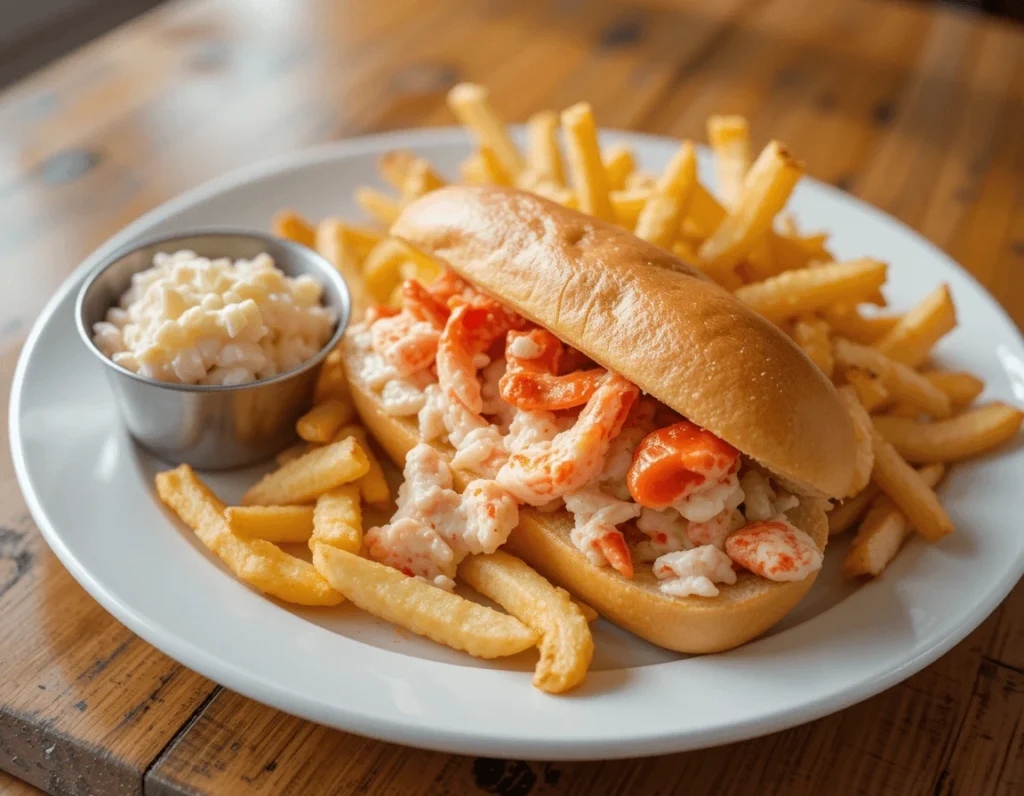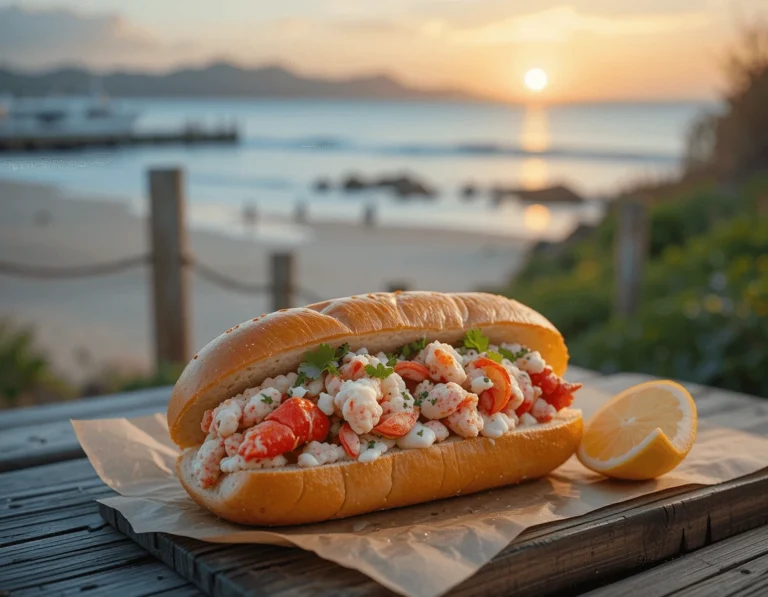Introduction
These delicious seafood sandwiches are more than just a meal—they’re an American culinary treasure, especially adored in the coastal regions of New England. Picture the tender, sweet taste of freshly cooked lobster, nestled in a warm, soft bun that’s been perfectly toasted. Whether it’s dressed in a rich, creamy mayonnaise or a simple, melt-in-your-mouth butter sauce, this dish delivers a flavor experience like no other.
Originating from the heart of New England, this iconic dish has quickly become a nationwide favorite. It’s the ideal mix of simplicity and indulgence—fresh lobster takes center stage, complemented by a simple yet mouthwatering preparation. Whether you’re enjoying it by the seaside with a beautiful view or recreating the experience in your own kitchen, this dish transports you straight to the coast with every bite.
In this article, we’ll explore everything you need to know about this beloved seafood treat. We’ll dive into its fascinating history, discuss the various regional twists (because not all versions are the same!), and guide you through the process of making it at home. Along the way, we’ll provide helpful tips and share interesting facts that will enhance your culinary experience.
Get ready for a flavorful journey into the world of this classic American dish—whether you’ve been a long-time fan or are trying it for the first time, this is a culinary experience you won’t want to miss!
What is a Lobster Roll?
A lobster roll is a classic seafood sandwich made with succulent lobster meat, traditionally served in a soft, toasted bun. What makes this dish special is its perfect blend of simplicity and richness—fresh lobster is the star, enhanced by just a few ingredients like creamy mayonnaise or melt-in-your-mouth butter sauce. The concept is simple, but the quality of the ingredients and preparation elevate it to an unforgettable culinary experience.
Whether you prefer your lobster roll with a light, creamy mayonnaise dressing or a savory, buttered coating, the essence of this dish lies in the premium lobster meat and the satisfying crunch of the perfectly toasted bun. It’s often garnished with fresh herbs or lettuce, adding texture and balance to each bite.
The History of the Lobster Roll
The lobster roll’s roots can be traced back to New England, particularly Maine, where it became a beloved dish in the early 1900s. At that time, lobster was plentiful and relatively inexpensive, making it an accessible delicacy for locals and visitors alike.
This iconic dish is often credited to Red’s Eats, a local eatery in Wiscasset, Maine, which began serving lobster rolls in the 1920s. Over time, it spread to other coastal towns in New England and eventually gained nationwide popularity.
In its early days, the lobster roll was often made with cold lobster meat dressed in mayonnaise and served in a buttered, toasted bun. The simplicity of the ingredients allowed the fresh lobster to shine, creating a satisfying and flavorful sandwich.
In the 1960s and 1970s, lobster rolls started to gain traction outside New England as tourism grew. Many restaurants across the U.S. began offering their own versions, and today, the lobster roll is enjoyed by seafood lovers all over the country. Different regions have put their own spin on the dish, with variations like the New England Lobster Roll (served cold with mayonnaise) and the Connecticut Lobster Roll (served warm and dressed with butter). Both versions celebrate the sweet, tender lobster meat in their own distinctive ways.
Over the years, the lobster roll has become a symbol of New England’s rich maritime culture. Whether enjoyed at a quaint roadside shack or made at home, it’s a dish that reflects the region’s deep connection to the sea.
Table of Contents
Table of Contents
Key Ingredients in a Lobster Roll
Below is a table listing the key ingredients for a basic lobster roll:
| Ingredient | Description | Amount (for 4 servings) |
|---|---|---|
| Lobster Meat | Fresh lobster meat is the key ingredient for the roll. | 2 whole lobsters (or 1.5 lbs) |
| Mayonnaise | Adds creaminess and enhances the lobster’s flavor. | 1/2 cup |
| Lemon Juice | A squeeze of fresh lemon brightens the flavors. | 2 tablespoons |
| Unsalted Butter | Used for toasting the buns and adding richness. | 2 tablespoons |
| Hot Dog Buns | Soft, slightly sweet buns to hold the lobster. | 4 buns |
| Chopped Parsley | Fresh herbs that garnish the roll and add color. | 1 tablespoon |
| Salt & Pepper | Season to taste. |

Types of Lobster Rolls
While lobster rolls may seem like a simple dish, there are distinct variations across different regions in the U.S., particularly between New England and Connecticut. These two types have evolved to reflect the tastes and preferences of the regions where they originated, making each one a unique and beloved version of the iconic lobster roll.
Traditional New England Lobster Roll
The New England Lobster Roll is the quintessential version of this dish, often considered the gold standard by lobster enthusiasts. Originating from Maine, this version of the lobster roll is known for its cool, creamy texture and light, fresh flavors.
- Serving Style: The lobster meat in a New England lobster roll is served chilled, providing a refreshing contrast to the rich, buttery bun.
- Lobster Preparation: The lobster meat is typically cooked, removed from the shell, and then lightly dressed with mayonnaise. Sometimes, a squeeze of fresh lemon juice is added for extra brightness, and a sprinkle of fresh herbs like chives or parsley can be used for additional flavor.
- Bun: The New England roll is traditionally served in a split-top hot dog bun, which is slightly toasted on the inside to create a crispy contrast with the tender lobster meat.
- Accompaniments: Typically, lettuce is included as a base layer in the bun, providing a crisp texture that balances the creamy lobster mixture.
This version of the lobster roll highlights the natural sweetness and tenderness of the lobster, allowing the meat to be the star of the show. The coolness of the lobster and the creaminess of the mayo make for a satisfying and indulgent bite.
Connecticut Lobster Roll
The Connecticut Lobster Roll, while still quintessentially a lobster roll, offers a different take by focusing on the savory richness of butter, which enhances the natural flavors of the lobster meat. This version is perfect for those who enjoy warm dishes that are rich in flavor.
- Serving Style: Unlike the New England lobster roll, the Connecticut version is served warm. The lobster meat is heated in melted butter, making it rich and indulgent.
- Lobster Preparation: The lobster is usually boiled or steamed, and then carefully removed from the shell. It is then tossed in hot butter, which infuses the meat with a rich, savory flavor.
- Bun: Just like the New England lobster roll, a split-top hot dog bun is used, but instead of being toasted on the inside, the bun is lightly buttered and grilled, giving it a crispy, golden exterior.
- Accompaniments: The Connecticut lobster roll often omits lettuce, allowing the buttery lobster to take center stage. Some variations might include a sprinkle of herbs or a dash of seasoning, but the focus remains on the lobster and butter.
The Connecticut lobster roll is perfect for those who enjoy a heartier, more savory version of the dish. The warm lobster, combined with the richness of butter, provides a comforting, luxurious bite. It’s a great choice for colder weather or when you’re craving a more indulgent meal.
Comparing the Two: New England vs. Connecticut Lobster Rolls
| Feature | New England Lobster Roll | Connecticut Lobster Roll |
|---|---|---|
| Lobster Preparation | Lobster is chilled and dressed in mayonnaise. | Lobster is served warm, tossed in melted butter. |
| Bun | Typically served in a split-top, buttered and toasted bun. | Served in a split-top bun, buttered and grilled. |
| Accompaniments | Often served with lettuce for crunch. | Usually served without lettuce. |
| Flavor Profile | Light, creamy, and refreshing. | Rich, savory, and buttery. |
| Regional Origin | Maine, New England. | Connecticut, New England. |
While both versions celebrate the same core ingredient—fresh, sweet lobster meat—they offer distinct experiences. The New England Lobster Roll tends to be lighter and more refreshing, making it perfect for a sunny day by the beach. The Connecticut Lobster Roll, on the other hand, is richer and heartier, making it ideal for those seeking a more indulgent lobster experience.
| Type of Lobster Roll | Serving Style | Preparation | Key Ingredient |
|---|---|---|---|
| New England Lobster Roll | Cold | Lobster meat mixed with mayo | Mayonnaise |
| Connecticut Lobster Roll | Warm | Lobster meat cooked in butter | Butter |

How to Make the Perfect Lobster Roll at Home
Step-by-Step Lobster Roll Recipe
Making lobster rolls at home is easier than it sounds. Below is the recipe for a classic lobster roll:
| Step | Instructions |
|---|---|
| Step 1 | Boil the lobsters in salted water for 10-12 minutes until the shells turn red. |
| Step 2 | Remove the lobster meat from the shells and chop it into bite-sized pieces. |
| Step 3 | Mix the lobster with mayonnaise, lemon juice, chopped parsley, salt, and pepper. |
| Step 4 | Butter and toast the buns in a skillet until golden brown. |
| Step 5 | Spoon the lobster mixture into the toasted buns and serve immediately. |
Tips for Perfect Lobster Meat Preparation
| Tip | Details |
|---|---|
| Fresh Lobster | Always opt for fresh lobster to get the best taste and texture. Frozen lobster is acceptable but may lack the same flavor. |
| Don’t Overcook | Lobster should be cooked just until opaque. Overcooking can make it rubbery. |
| Chill the Lobster Meat | For a refreshing roll, chill the lobster meat in the fridge before mixing it with the dressing. |
Lobster Roll Variations
You can customize lobster rolls with different sauces and fillings to give them a unique twist.
Adding Flavors with Different Sauces
| Sauce | Flavor Profile | Ingredients |
|---|---|---|
| Mayonnaise-Based Sauce | Creamy and tangy, adds richness. | Mayonnaise, lemon juice, tarragon, dill |
| Lemon Butter Sauce | Rich and buttery with a citrus kick. | Butter, lemon juice, garlic, salt |
Vegetarian Alternatives to Lobster Rolls
If you’re not a fan of lobster or want a vegetarian alternative, here are some ideas:
| Alternative | Description |
|---|---|
| Jackfruit | Its flaky texture mimics lobster and can be seasoned to taste. |
| Tofu | Tofu can be sautéed and seasoned to resemble the texture of lobster. |

Lobster Roll Pairings
Lobster rolls are delicious by themselves, but they can be made even better with the right pairings.
Best Drinks to Serve with Lobster Rolls
| Drink | Description |
|---|---|
| White Wine | A crisp, dry white wine like Sauvignon Blanc or Chardonnay complements the lobster’s sweetness. |
| Lemonade | A refreshing non-alcoholic drink that balances the richness of the lobster. |
| Beer | Light beers such as pilsners or wheat beers are perfect for pairing with lobster rolls. |
Sides That Complement a Lobster Roll
| Side | Description |
|---|---|
| French Fries | Crispy, golden fries are a perfect complement to the buttery lobster roll. |
| Coleslaw | Tangy and creamy coleslaw adds freshness and crunch. |
| Pickles | A crunchy and sour pickle side cuts through the richness of the lobster roll. |
Lobster Roll Health Benefits
While lobster rolls can be indulgent, they can also be part of a balanced diet.
Nutritional Value of Lobster Meat
| Nutrient | Amount (per 3 oz of lobster) |
|---|---|
| Calories | 70 kcal |
| Protein | 14 grams |
| Fat | 1 gram |
| Vitamin B12 | 1.2 mcg |
| Sodium | 300 mg |
Why Lobster Rolls Can Be a Healthy Option
Lobster meat is rich in protein and low in fat, making it a great option for those looking for a healthy seafood dish. Pairing it with healthier sides like salad or coleslaw can enhance its nutritional value.
Where to Find the Best Lobster Rolls
If you’re not in the mood to cook, here’s a list of some of the best places to find lobster rolls.
| Location | Description |
|---|---|
| Red’s Eats, Wiscasset, Maine | Known for its massive lobster rolls, Red’s Eats is a must-visit for lobster lovers. |
| The Lobster Shack, Cape Elizabeth, Maine | A scenic lobster shack serving fresh lobster rolls with ocean views. |
| Eventide Oyster Co., Portland, Maine | Famous for its unique lobster rolls, Eventide brings a modern twist to this classic. |
Lobster-filled bun FAQs
“How can I make a Lobster-filled bun at home?”
You can follow a simple recipe using fresh lobster meat, mayonnaise, and a toasted bun. Add seasonings or herbs to customize the flavor.
“What is the difference between a Connecticut and New England Lobster-filled bun?”
A Connecticut Lobster-filled bun uses warm lobster meat with butter, while the New England version uses chilled lobster meat with mayonnaise.
“Can I use frozen lobster for Lobster-filled bun?”
Yes, frozen lobster can be used, but fresh lobster will always provide the best flavor and texture.
“What type of bread is best for Lobster-filled bun?”
A soft, slightly sweet hot dog bun is the traditional choice for Lobster-filled bun.
“Are Lobster-filled bun healthy?”
Lobster-filled bun can be a healthy meal option, especially when made with fresh lobster and served with healthy sides.
“Can I add cheese to a Lobster-filled bun?”
While not traditional, some people enjoy adding cheese to their lobster rolls for a different flavor experience.
Conclusion: Why You Should Try a Seafood Bun Today
Seafood buns are one of the most iconic dishes in American cuisine, loved for their simplicity and the delicate, sweet flavor of fresh lobster meat. Whether you enjoy it with a creamy mayonnaise dressing or a rich, buttery coating, the contrast between the soft, warm bun and the tender lobster creates a mouthwatering experience that’s hard to beat.
Seafood buns can be easily made at home or enjoyed at one of the many renowned seafood shacks along the U.S. coastline, particularly in New England, where the dish originated. What makes seafood buns truly special is their versatility. You can experiment with different sauces, add fresh herbs, or even opt for a healthier option using whole-grain buns or lighter dressings. Whether you’re craving a traditional version or a more modern take, there’s a seafood bun for every taste.
Beyond being just a meal, seafood buns offer a full dining experience. Enjoying one means soaking in a fresh, coastal vibe—whether you’re dining by the ocean or recreating the ambiance in your kitchen. They’re perfect for a special treat, a weekend get-together with friends, or even a family celebration.
But there’s more to seafood buns than just their deliciousness. They give you a taste of American culinary history. For many, they bring back memories of summer vacations by the beach or unforgettable meals at hidden seafood gems. Every bite connects you to the rich maritime culture that has shaped this dish into a nationwide favorite.
So, whether you’re trying one for the first time or are a lifelong lobster lover, don’t miss the chance to try a seafood bun today. If you’ve never made one at home, now’s the perfect time to experiment with different recipes and discover your personal favorite style. And if you’re near a place renowned for its seafood buns, make sure to stop by and taste the freshest lobster available.
Remember, a seafood bun is more than just a sandwich—it’s a celebration of everything that makes seafood so special: freshness, simplicity, and unforgettable flavor. Go ahead, treat yourself to one and savor the taste of one of the finest delicacies the ocean has to offer!
Internal Links:
- How to Cook Lobster Perfectly
- Top Seafood Recipes You Need to Try
- Healthy Seafood Recipes for a Balanced Diet
- Best Seafood Restaurants in the USA

Lobster Roll – The Ultimate Guide to Making the Perfect Lobster Roll
A Seafood Bun is a delicious and indulgent seafood sandwich featuring tender lobster meat nestled in a warm, buttered bun. It’s typically dressed with a creamy mayonnaise or rich butter sauce, making each bite a flavorful coastal treat. Whether you prefer it classic or with a modern twist, the seafood bun is a must-try dish that brings the flavors of the sea straight to your plate.
- Total Time: 35 minutes
- Yield: 4 seafood buns 1x
Ingredients
2 whole lobsters (or 1.5 lbs lobster meat)
4 soft hot dog buns (preferably split-top)
1/2 cup mayonnaise (for the dressing)
2 tablespoons lemon juice (freshly squeezed)
2 tablespoons unsalted butter (for toasting buns)
1 tablespoon fresh parsley (chopped, for garnish)
Salt and pepper (to taste)
1 tablespoon chives (optional, for garnish)
2 cups iceberg lettuce (optional, for crunch and garnish)
Instructions
Boil the Lobster: Bring a large pot of salted water to a boil. Add the lobsters and cook for 10-12 minutes until the shells are bright red. Remove the lobster from the pot and let it cool.
Prepare the Lobster Meat: Once the lobsters are cool enough to handle, remove the meat from the shells. Chop the lobster meat into bite-sized pieces.
Make the Dressing: In a bowl, mix together the mayonnaise, lemon juice, salt, and pepper. Gently fold in the lobster meat until well combined.
Toast the Buns: In a skillet, melt the butter over medium heat. Lightly toast the inside of the buns until golden brown and crispy.
Assemble the Seafood Buns: Place a layer of lettuce in each toasted bun (optional). Then, spoon the lobster mixture into the buns, making sure to fill them generously.
Garnish and Serve: Garnish with chopped parsley and chives (optional). Serve immediately and enjoy the freshest seafood sandwich you can make!
Notes
Customization: Feel free to adjust the dressing to your taste. You can add a little mustard or dill for a unique twist.
Lobster Substitution: If fresh lobster is not available, you can substitute with pre-cooked lobster meat or even shrimp.
Serving Tips: Serve with crispy French fries, a side of creamy coleslaw, or pickles for a perfect seafood meal.
- Prep Time: 20 minutes
- Cook Time: 15 minutes (to cook lobster and toast buns)
- Category: Main Course, Seafood, Sandwiches
- Method: Boiling, Toasting
- Cuisine: American, New England
- Diet: Gluten Free
Nutrition
- Serving Size: 1 seafood bun
- Calories: 450 kcal
- Sugar: 1g
- Sodium: 580mg
- Fat: 22g
- Saturated Fat: 6g
- Unsaturated Fat: 12g
- Trans Fat: 0g
- Carbohydrates: 38g
- Fiber: 2g
- Protein: 32g
- Cholesterol: 90mg
Keywords: Lobster roll, seafood bun, lobster sandwich, seafood recipe, New England lobster, summer sandwich, coastal dish


